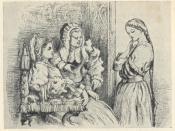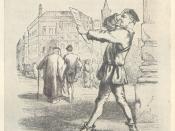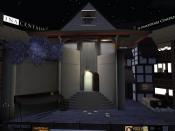Lady Capulet uses language and imagery, in Act I, Scene 3 of Shakespeare's Romeo and Juliet, to express her beliefs and feelings about why her daughter Juliet should marry Count Paris. First, Lady Capulet talks about how handsome Paris is. She says, "And find delight writ there with beauty's pen" (Act 1, Scene 3, Line 88) and "what obscured in this fair volume lies" (Act 1, Scene 3, Line 91). Lady Capulet uses the image of a book to convey her belief that Paris, like a handsome or elegant book, is attractive. She urges Juliet to appreciate that handsome appearance. Second, Lady Capulet goes on use the image of the unbound book to emphasize that Paris is not married or looking at any other women. She urges Juliet to find his availability an asset with her words, "This precious book of love, this unbound lover" ( Act 1, Scene 3, Line 93) and " to beautify him only lacks a cover" (Act 1, Scene 3, Line 94).
Further, still using the imagery of a book, Lady Capulet says to Juliet that all that is needed is a cover for the book. By this comparison, she suggests that Juliet is the cover that can complete the volume, of Paris, by agreeing to marry the young nobleman. Finally, Lady Capulet also tells her daughter that Paris has the right or appropriate social status. Lady Capulet tells Juliet, "By having him, making you yourself no less" (Act I, Scene 3, Line 100). Lady Capulet reflects the importance for noble families in England of that timeto maintain their standing in society. Marrying someone such as Count Paris, who is considered at the same high social level as the Capulet family, is one of the ways to keep the good name of...



Romeo and Juliet
Lady Capulet did not show much understanding of a teenage girl, much less her own daughter, if she thought comparing Paris to a book would be an appealing image. Juliet would surely be more interested in the possibility of love than bookish interests, notwithstanding her realization of the requirements of duty.
5 out of 5 people found this comment useful.